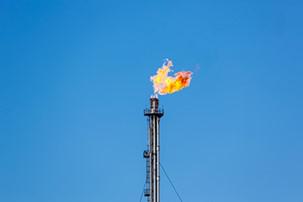Often, bright orange flames can be seen dancing atop vertical pipes that rise above landscapes where oil and gas is retrieved from below the ground. It’s called flaring and it is a way to dispose of associated gases that come with oil production. It’s a practice that has been used for nearly 160 years when other options for the use or transport of the gas are not readily available to the producers, but it’s also a source of greenhouse gas emissions and significant waste of a valuable natural resource that could be used to make useable products.
That’s why NETL is supporting research projects to address situations where more traditional uses of associated gas are not available and to develop efficient conversion technologies that can produce useable solids and liquids while reducing methane emissions.
According to the World Bank's Global Gas Flaring Reduction Partnership (GGFR), the amount of gas that is currently flared each year – about 144 billion cubic meters – “could power the whole of sub-Saharan Africa.”
“Gas flaring contributes to climate change and impacts the environment through emission of CO2 (carbon dioxide) black carbon and other pollutants,” GGFR maintains. “It is estimated that each cubic meter of associated gas flared results in about 2.8 kilograms of CO2-equivalent emissions. At current levels, global flaring is estimated to result in about 400 million tons of CO2-equivalent emissions annually.”
A study by Texas A&M found that at flaring sites it studied, “flares produced about 10 times more NOx (nitrogen oxides) than cars in the area” and “the large number of flares and high variability of NOx production per flare can cause large-scale atmospheric impacts visible from space.”
NETL’s William Fincham and Robert Noll recently wrote in an article published on WorldOil.com that one of the main areas of interest of the U.S. Department of Energy’s (DOE) Methane Mitigation Technologies program, supported by NETL “is to develop process-intensified technologies for the conversion of flare/venting gas into transportable, value-added liquid products.”
Current natural gas to liquids (GTL) technologies that could reduce flaring face significant challenges. Many production sites are isolated and lack access to the electricity, make-up water and other services required to operate these types of conversion technologies. In addition, existing GTL technologies are complicated, inefficient and environmentally unfriendly, which make them too costly in existing commodity markets.
Fincham and Noll’s article explained that the focus of new research is on converting flared natural gas into liquid and solid products. To be successful, researchers must: develop new catalysis materials; create processes that can operate without convenient access to electricity and water services and be highly efficient at lower temperatures; innovate modular, compact, integrated and transportable reactor designs; and develop technology platforms that can produce a variety of useful market quality products.
They noted that two promising NETL-funded projects align with the need to develop efficient natural gas conversion technologies that produce marketable solids and liquids to mitigate methane emissions into the atmosphere.
One project led by the University of Notre Dame uses plasma stimulation of a light hydrocarbon resource to synthesize value-added liquid chemicals at production sites. Noll wrote that the project offers the opportunity to potentially reduce quantities of flared gas at oil and natural gas production sites where gas transport options are insufficient or do not exist, by converting the gas to energy-dense liquid products. The project team will continue to develop the approach with characterization and computer simulations. Additional experimental testing, including alternative plasmas, will also be evaluated.
Fincham explained that a second project led by the University of Colorado, is developing a low-cost and scalable natural gas decarbonization process to form nanoparticles and nanofibers for use as a structural additive in concrete. The project will focus on synthesizing carbon nanoproducts through chemical vapor deposition and examining how the fibers add to the durability of concrete. The process is designed to be modular and mobile with easy transport between gas wells. The project team plans to continue with lab-scale testing while constructing a skid-mounted modular version of the reactor. A process also will be developed for a large-scale synthesis of the required catalyst.
Fincham and Noll added that NETL currently supports a range of additional natural gas conversion projects including:
NETL is a U.S. Department of Energy national laboratory that drives innovation and delivers technological solutions for an environmentally sustainable and prosperous energy future. By leveraging its world-class talent and research facilities, NETL is ensuring affordable, abundant and reliable energy that drives a robust economy and national security, while developing technologies to manage carbon across the full life cycle, enabling environmental sustainability for all Americans.




